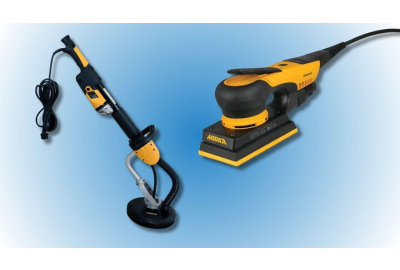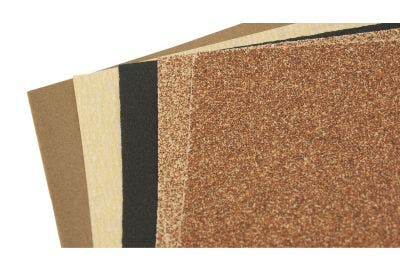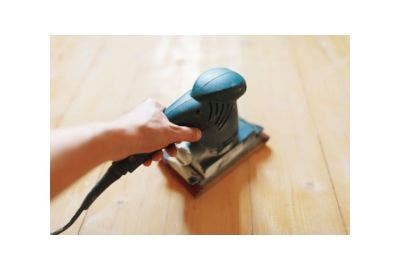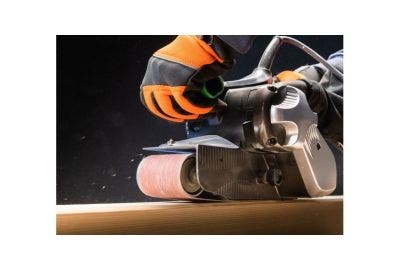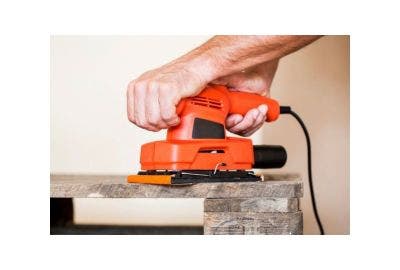In woodworking and DIY projects, the right tools are essential for achieving the best results. Sanders plays a major role in preparing and finishing surfaces, meaning they are smooth and ready for further work.
With so many different types of sanders available, each designed for specific tasks, choosing the right one can be challenging, especially for those new to the craft or working on specialised projects.
This guide introduces the eight main types of sanders, detailing their features and best uses. Whether you're a DIY enthusiast starting your first project, a seasoned woodworking professional, or a hobbyist refining your skills, understanding which sanding tools you need is key to achieving a flawless finish.
By the end of this guide, you’ll be equipped with the knowledge to select the best tool for your next project.
Belt Sanders

Overview
Belt Sanders are powerful and versatile tools designed for rapid material removal. It operates using an electric motor that drives a pair of drums, rotating a continuous loop of sandpaper, also known as a sanding belt. This makes it ideal for tackling large, flat surfaces with ease.
Belt sanders are available in various sizes, from compact handheld models to larger stationary units, offering flexibility for different tasks.
These tools are particularly effective on tough materials like hardwood, making them a go-to choice for levelling surfaces and preparing wood for finishing. Whether you're a professional handling extensive projects or a DIY enthusiast working on home improvements, a belt sander can significantly reduce your workload. However, due to their power, they require careful handling to avoid over-sanding or damaging the workpiece.
Best Uses
Belt sanders excel at working on large, flat surfaces, making them ideal for smoothing rough wood, levelling surfaces, and quickly removing paint or varnish. Their efficiency on hardwood and other durable materials means they are a staple in any workshop, whether you're working on a large tabletop, wooden floor, or outdoor decking.
While belt sanders are highly effective, they are not suitable for delicate tasks or fine finishing due to their aggressive nature. They require a steady hand to prevent creating uneven surfaces or grooves. It’s also advised to use appropriate safety gear, such as goggles and a dust mask, as these tools can produce a significant amount of dust and debris.
Disc Sanders

Overview
Disc sanders are versatile tools featuring a circular sanding disc mounted on a rotating platform, powered by an electric motor. Available in both handheld and bench-mounted versions, disc sanders cater to different needs. Handheld models offer portability for working on larger, uneven surfaces, while bench-mounted versions provide stability and precision for detailed tasks.
These sanders come with a variety of disc sizes and grit levels, allowing users to choose the right one for specific jobs. Their ability to swap out discs easily makes them adaptable for different materials, from heavy material removal to fine finishing. Disc sanders are particularly effective on edges, making them excellent for smoothing, shaping, and finishing wood, metal, and plastic.
Best Uses
Disc sanders are ideal for precise edge work and are frequently used for tasks requiring careful attention to detail. They excel at shaping and finishing wood, especially when dealing with corners or complex shapes. The controlled removal of the material makes it easier to achieve the desired finish without over-sanding.
However, it’s important to be mindful of the speed and pressure applied to avoid overheating or damaging the material. Safety precautions, such as using dust extraction systems and wearing protective gear, are essential to prevent dust inhalation and other hazards.
Orbital Sanders

Overview
Orbital sanders are easy-to-use tools that offer versatility in both woodworking and DIY projects. They feature a circular or square sanding pad that moves in a consistent orbit, creating a smooth, even finish across various surfaces. The sanding motion of an orbital sander is less aggressive than other types, making it ideal for tasks that require a gentle touch.
Lightweight and easy to control, orbital sanders are suitable for both beginners and experienced users. They work well on flat surfaces and can handle contoured areas, although they are best for light to medium sanding tasks rather than heavy material removal. These sanders are compatible with a range of sandpaper grits, allowing users to switch between rough and fine sanding as needed.
Best Uses
Orbital sanders are perfect for light sanding tasks and finishing work. They are particularly effective for preparing surfaces for painting or staining, as their gentle action leaves surfaces smooth without creating visible marks or grooves. Their ability to sand in tight spaces and along edges adds versatility for various projects.
When using an orbital sander, it's important to keep the tool moving consistently, to avoid over-sanding any area. Using the right grit for the job will yield the best results, whether you are smoothing rough surfaces or applying a fine finish.
Random Orbital Sanders

Overview
Random orbital sanders are an advanced version of standard orbital sanders, offering greater versatility and power. What sets them apart is their unique motion pattern—while the sanding pad orbits in a circular motion, it also moves in a random pattern. This dual action helps prevent swirl marks, making random orbital sanders an excellent choice for achieving a smooth, professional finish.
Highly versatile, these sanders can be used on various materials, including wood, metal, and plastic. They come with different types of sanding pads that attach easily, allowing for quick changes between rough and fine sanding. Their design suits both DIY enthusiasts and professionals who need a reliable tool for a wide range of sanding tasks.
Best Uses
Random orbital sanders are effective for both rough and fine sanding tasks, thanks to their ability to prevent swirl marks and achieve an even finish. They are particularly useful on larger surfaces where consistent, high-quality finishes are required without the risk of visible sanding lines.
These sanders are commonly used in woodworking, metalworking and even auto body repair. Their versatility makes them suitable for various projects, from preparing surfaces for painting to sanding down old finishes. Using the correct grit and applying even pressure will help avoid damaging the material.
Detail Sanders

Overview
These products, also known as corner sanders, are compact tools designed for precision work. Their small size and triangular sanding pads make them ideal for reaching tight spots, such as corners, edges, and intricate details that larger sanders can't access. The triangular shape allows users to work in confined spaces and on detailed surfaces with greater control.
Popular for tasks that require careful attention to detail, detail sanders are excellent for finishing fine woodworking projects or removing old paint from tight spaces. Lightweight and easy to manoeuvre, detail sanders are a great choice for both DIY enthusiasts and professionals who need precision in their work.
Best Uses
They excel at sanding corners, edges, and small surfaces. They are highly effective in removing old paint, varnish, or stains from detailed areas where other sanders might struggle. Their precision makes them ideal for finishing detailed woodworking projects, such as furniture restoration or intricate mouldings.
Using the appropriate grit for the task at hand will help avoid damaging delicate surfaces. Their ease of use and control allows for precise sanding without the risk of over-sanding or creating uneven surfaces.
Drum Sanders

Overview
Drum sanders are powerful machines designed for heavy-duty sanding tasks, often used in professional woodworking and flooring projects. A drum sander features a rotating drum covered with sandpaper, which sands the surface as it spins. Available in both stationary and walk-behind models, these sanders are tailored to the specific needs of large-scale projects.
Drum sanders are particularly effective at sanding large, flat surfaces, making them ideal for refinishing hardwood floors or smoothing large wooden panels. Their design allows for the use of various grit sandpapers, enabling users to start with coarse grits for rapid material removal and finish with finer grits for a smooth surface.
Best Uses
Drum sanders are best suited for extensive projects that require significant sanding. Commonly used to sand hardwood floors, large wooden panels, and other expansive surfaces, their power allows for the removal of substantial material quickly, making them ideal for levelling surfaces or removing old finishes.
While highly effective, drum sanders require careful handling. Their aggressive sanding action can lead to over-sanding or creating uneven spots if not used correctly. Proper techniques, such as maintaining a consistent pace and using appropriate safety gear, are essential to avoid dust inhalation and other hazards.
Spindle Sanders

Overview
Spindle sanders are specialised tools designed for sanding curves, contours, and intricate shapes in wood and other materials. These sanders feature a vertical, oscillating spindle that moves up and down while rotating, providing even sanding across the surface. Different sizes of sanding sleeves can be fitted to the spindle, making the tool versatile for various projects.
The oscillating motion of the spindle sander reduces the risk of gouging or uneven sanding is required when working on curved or detailed pieces. Spindle sanders are often used in woodworking shops for tasks like smoothing internal cuts, sanding the edges of curved surfaces, and refining intricate details on furniture or decorative pieces.
Best Uses
Spindle sanders excel at sanding curved and contoured edges, making them particularly effective for smoothing internal cuts, such as those found in chair legs or table edges. The ability to switch between different spindle sizes allows users to match the sander to the specific curve or contour they are working on, which provides a uniform finish.
These sanders are also useful for refining the edges of detailed woodworking projects where a standard sander might struggle to maintain precision. Selecting the correct spindle size and sandpaper grit for the material and project will yield the best results. Proper safety measures, including dust collection and protective gear, are essential to avoid health hazards.
Edge Sanders
Overview
Edge sanders are specialised tools designed for sanding the edges of boards, panels, and other flat materials. Featuring a horizontal sanding belt mounted on a flat surface, these sanders allow the user to press the material against the belt for precise edge sanding. Edge sanders are particularly useful in woodworking shops where smooth, even edges are essential for joinery and finishing.
The horizontal design provides stability and control, making it easy to achieve consistent results. These sanders come in various sizes and configurations, including both floor-standing and benchtop models, to accommodate different projects. The adjustable angle of the sanding belt adds versatility, enabling users to sand bevels and angled edges with precision.
Best Uses
Edge sanders are ideal for tasks involving sanding long edges, and bevels, and straightening or smoothing large panels. Commonly used in cabinetry, furniture making, and any project where clean, precise edges are needed, these tools provide edges that are perfectly square or bevelled to the desired angle.
In addition to straight edges, edge sanders can be used for sanding curved edges or evening out imperfections in the material, making them versatile for various woodworking tasks. Consistent pressure and a steady feed rate are needed to avoid burning or uneven sanding marks. Proper safety measures, such as dust extraction and protective equipment, are important to prevent exposure to dust and debris.
It's important to select the right tool for the job, considering the specific needs of your project. Whether you're working on large surfaces, edges, curves, or fine details, the right sander will make the difference between a smooth, professional finish and a less-than-perfect result.
We encourage you to carefully assess your project requirements and choose the sander that best suits your needs. If you need further guidance or have any questions about sanding tools, Heamar is here to help.



